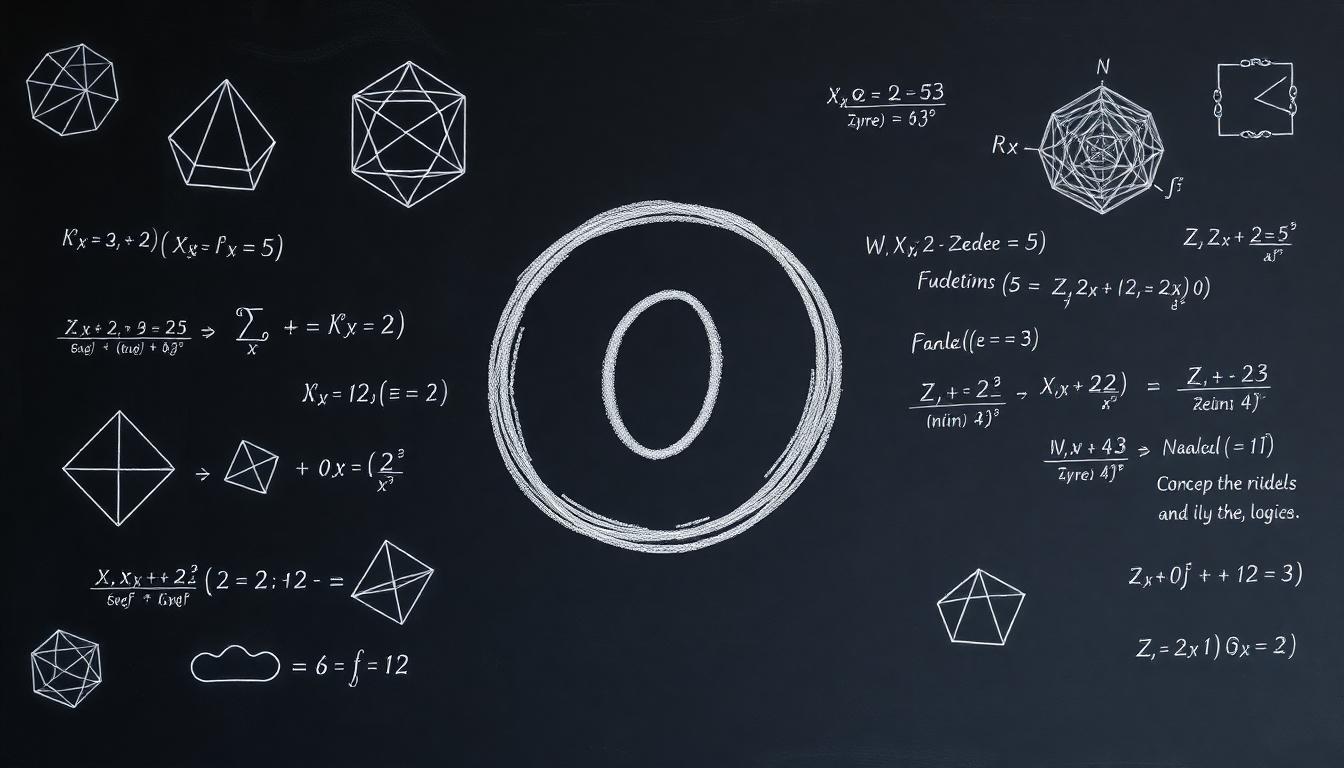Looking for a brain teaser that will truly make you think outside the box? Nothing could be more puzzling than riddles about… well, nothing! These clever wordplays and mental gymnastics challenge our perception and force us to consider the concept of nothingness in entirely new ways.
10 Mind-Bending Riddles About Nothing That Will Test Your Wits
- What gets bigger the more you take away?
A hole grows larger with each scoop of dirt removed. This paradoxical riddle highlights how nothingness can expand when surrounding substance diminishes.
- What can you hold in your right hand but never in your left?
Your left hand is the answer. You can’t hold your left hand in your left hand—it’s impossible to grasp nothing where something already exists.
- What starts with “e,” ends with “e,” but only contains one letter?
An envelope holds nothing before you put a letter inside it. The wordplay here cleverly disguises the container of emptiness.
- What can you break even if you never pick it up or touch it?
Silence breaks when sound interrupts it. This riddle illustrates how nothing (silence) can be disrupted without physical contact.
- What’s full of holes but still holds water?
A sponge seems like it should hold nothing due to its holes, yet it retains water through its unique structure.
- What can run but never walks, has a mouth but never talks?
A river has a mouth but contains no actual speaking apparatus. The emptiness of its “mouth” about communication challenges our associations.
- What has a head and a tail but no body?
A coin possesses both features with nothing between them. This absence of a body creates the riddle’s conceptual twist.
- What can you catch but not throw?
A cold can be caught but never thrown. The nothingness you’re “catching” manifests as illness even though having no physical form.
- What room can no one enter?
A mushroom has “room” in its name but offers no space for entry. The wordplay focuses on the absence of actual room even though the name.
- What gets wetter as it dries?
A towel absorbs moisture (nothing) from other objects while becoming wetter itself. This contradiction showcases how an object can simultaneously gain and remove nothing (dryness).
The Philosophical Void: Riddles That Contemplate Nothingness

Riddles about nothingness take us beyond simple wordplay into the area of paradoxes, existential concepts, and profound philosophical questions. These brain teasers challenge our understanding of absence and emptiness while exploring the boundaries between existence and non-existence.
Ancient Paradoxes of Emptiness
The contemplation of nothingness has fascinated philosophers since antiquity, with Zeno’s paradoxes from the 5th century BCE standing as early examples. These ancient thought experiments challenged fundamental notions of motion and plurality by suggesting reality is singular and static. Zeno’s arguments against plurality proposed that accepting multiple entities inevitably leads to logical contradictions, indirectly examining the concept of “nothing” through negation. Many ancient riddles built on this foundation, including the self-contradictory statement “I exist because I am not,” which frames nothingness as a paradoxical foundation for existence. Such puzzles force us to confront the limitations of language when describing absence and question whether true emptiness can even be conceptualized.
Modern Brain Teasers on the Concept of Zero
Contemporary riddles continue this philosophical tradition by using clever abstraction to explore the concept of absence in fresh ways. Consider this paradoxical question: “What can be created by destroying something?” The answer—a hole or empty space—reflects the contradiction inherent in our definitions of emptiness. Another mind-bending example asks, “What’s always in front of you but can’t be seen?” with the answer being “the future”—symbolizing uncertainty as a void waiting to be filled. We also encounter riddles like “I am not alive, but I grow; I need air but lack lungs,” which describes fire, representing non-living forces that embody groundbreaking absence. These modern brain teasers merge logical reasoning with metaphysical inquiry, inviting us to reflect on the nature of negation, potential, and the boundaries of our perception.
Wordplay Wonders: Riddles Where “Nothing” Is the Answer

The concept of “nothing” serves as both the perfect puzzle and the perfect answer, creating some of the most clever wordplay riddles known to humanity.
Classic Nothing Riddles Throughout History
One of the most enduring nothing-based riddles challenges our understanding of existence itself: “What is greater than God, more evil than the devil, the poor have it, the rich need it, and if you eat it, you’ll die?” The answer is simply “nothing.” Nothing is greater than God in theological contexts, nothing is more evil than the devil in moral frameworks, poor people have nothing, rich people need nothing, and eating nothing leads to starvation. This classic brainteaser has survived centuries because of its elegant use of paradox and contradiction that only “nothing” can resolve. Various phrasings exist across cultures (sometimes appearing as “the rich don’t need it”), but the core concept remains unchanged through generations of puzzlers.
Deceptively Simple Nothing-Based Puzzles
Some nothing riddles appear straightforward but contain surprising depth. Consider this spatial paradox: “What’s the hardest thing to find, even though it’s everywhere? It’s around you, yet it’s barely there.” The answer is “nothing,” highlighting how absence surrounds us yet remains impossible to grasp. Another arithmetic puzzle asks, “What can you subtract from itself and still get the same? It’s a tricky thing, with no name.” This riddle cleverly plays with mathematical properties since nothing (zero) remains nothing when subtracted from itself. We also encounter philosophical riddles like “What has no beginning, no middle, no end, yet remains the absence you can’t comprehend?” These deceptively simple formulations challenge our perception of existence and void, transforming “nothing” from a simple concept into a profound puzzle piece.
Mathematical Mysteries: Zero and Void Conundrums

Zero stands as mathematics’ most enigmatic character – a symbol representing both absence and powerful mathematical properties. In the industry of riddles, zero and void concepts challenge our understanding of nothingness while revealing fascinating mathematical truths.
Number Riddles Where Nothing Matters
Zero-based puzzles often exploit this number’s unique properties to create compelling brain teasers. Consider this classic riddle: “What number multiplied by any other always yields the same result?” The answer is zero, highlighting its distinctive multiplicative property. Another intriguing zero-based puzzle presents it as a number that’s “both odd and even” – technically even (divisible by 2) but sometimes categorized as neither in exact mathematical contexts.
Void concepts extend beyond zero itself. Take the riddle “I’m always coming but never arrive,” which refers to infinity (∞) – a concept representing endless continuation or a kind of mathematical void. Similarly, “What number eats itself?” points to eight (8), which when rotated resembles the infinity symbol (∞), cleverly connecting to the idea of insatiability or endless consumption.
Family relationship riddles can also incorporate “nothing” concepts. A popular example asks: “How can three generations (grandfather, father, son) buy three movie tickets for $21?” The solution requires recognizing the overlapping family roles – even though the language suggesting five people (“two fathers, two sons”), there are actually just three individuals. This riddle works through a logical void in our perception.
Geometric Puzzles About Empty Space
Geometric riddles frequently incorporate empty space or zero concepts as central challenges. Subtraction riddles involving zeros, such as operations like 1000−325, require handling empty placeholders during regrouping. These puzzles test our understanding of how to work with “nothing” in mathematical operations.
Spatial reasoning puzzles often challenge us to visualize empty or negative space. While explicit examples are less common, these types of riddles typically require recognizing how voids or empty areas contribute to the overall problem. The concept of partitioning shapes to create empty sections represents this category, though such examples are more abstract in nature.
Mathematical void riddles demonstrate how zero isn’t merely emptiness but a powerful concept worth exploring. These puzzles transform abstract mathematical properties into captivating challenges that stretch our understanding of what “nothing” truly means in the industry of numbers.
Pop Culture’s Favorite Nothing Riddles

While not always explicit, riddles about nothing have found their way into various forms of entertainment, challenging audiences to think beyond conventional boundaries. They appear in subtle ways across popular media, inviting viewers and readers to contemplate the concept of nothingness.
Nothing Riddles in Movies and TV Shows
Popular films like “The Goonies” and “Pirates of the Caribbean” showcase intricate puzzles that require creative thinking and abstract problem-solving skills. These movies don’t directly focus on nothingness, but they introduce the audience to mind-bending challenges that often involve looking at what isn’t there rather than what is. TV shows have also embraced philosophical riddles about existence and absence. “Westworld,” for instance, presents characters with existential dilemmas that explore the thin line between something and nothing, encouraging viewers to question reality itself. The show’s complex narrative frequently incorporates abstract puzzles that touch on themes of emptiness and non-existence.
Famous Nothing Riddles From Literature
Literary works have long explored the concept of nothingness through various riddles and metaphorical expressions. Ernest Becker’s “The Denial of Death” delves into human anxieties about nothingness and mortality, presenting philosophical questions that function as riddles about our existence. Poetry frequently employs the theme of absence, with poets using the concept of nothing to reflect on deeper meanings of life. Samuel Beckett’s works stand out for their prevalent exploration of emptiness and nothingness, challenging readers to confront the void that exists in human experience. Classic riddles like “What’s the hardest thing to find, even though it’s everywhere? Answer: Nothing” have become part of our cultural lexicon, though they rarely trace back to exact literary sources. These brain teasers represent our collective fascination with the paradox of nothingness—something that simultaneously doesn’t exist yet pervades everything.
Creating Your Own Riddles About Nothing

Ready to create your own mind-bending riddles about nothing? Focus on paradoxes, metaphors, and abstract concepts to design puzzles that will challenge and entertain. Effective nothing riddles often play with homophones like “knot” versus “not” or use literal interpretations of nothingness. Consider examples like “I’m always present but never seen. What am I?” (Answer: Nothing) or “You can hold me but I weigh nothing. What am I?” (Answer: Breath).
Key Techniques for Crafting Nothing-Based Brain Teasers
Ambiguity serves as a powerful tool when creating riddles about nothing. Frame questions around absence or emptiness, such as “What grows smaller the more you take from it?” with the answer being “a hole.” The concept of absence creates an intriguing contradiction that makes these riddles particularly captivating.
Double meanings offer another effective approach to crafting nothing-themed puzzles. Use phrases that have hidden interpretations like “the end of everything” (answer: the letter ‘g’) or “the top of nothing” (answer: a mountain peak with ‘nothing’ beneath it). These wordplay techniques create satisfying “aha” moments when solved.
Visual paradoxes incorporate intangible concepts that represent different forms of nothingness. Silence, shadows, and empty space can all serve as creative answers to your riddles, challenging solvers to think beyond physical objects. These abstract representations expand the possibilities for your nothing-based brain teasers.
Ways to Challenge Friends With Your Nothing Riddles
Timed riddle chains create an captivating interactive experience for your friends. Present sequential nothing-themed riddles that build upon each other, such as “I have teeth but can’t eat. What am I?” (Answer: Comb) followed by “What has teeth but no mouth?” (Answer: Zipper). This format keeps participants engaged through multiple challenges.
Metaphor-laden puzzles draw inspiration from existing riddles to create compelling challenges. Try examples like “Nothing inside, nothing outside… light as a feather, yet ten men can’t lift me” with the answer being “bubble.” These rich descriptions provide just enough clues while maintaining the mystery.
Interactive guessing games pair abstract answers with tangible objects for an captivating experience. Questions like “What do you buy to eat but never consume?” (Answer: Cutlery) encourage players to think laterally about everyday items. Wordplay riddles also offer excellent opportunities, such as “We are nothing, yet everything begins with us. What are we?” (Answer: The letter ‘E’).
The Cognitive Benefits of Solving Riddles About Nothing

Solving riddles about abstract concepts like “nothing” offers surprising cognitive advantages that extend far beyond mere entertainment. The classic riddle “What can be as big as an elephant but weigh nothing?” (with the answer being “its shadow”) perfectly demonstrates how these puzzles train our minds to identify indirect connections and move past surface-level assumptions.
Enhances Critical Thinking
Riddles about nothing activate exact brain regions linked to problem-solving and language processing. These mental challenges demand analysis of implicit meanings rather than literal interpretations, forcing us to examine information from multiple angles. When we encounter a riddle about nothingness, our brains must work harder to abandon conventional thinking patterns and explore alternative answers.
Strengthens Memory and Focus
Deciphering the wordplay in nothing-themed riddles significantly reinforces working memory capabilities. The process requires us to retain multiple clues simultaneously while mentally testing different hypotheses. This cognitive juggling act creates neural pathways that improve information retention and sharpen focus, making these riddles valuable mental exercises for people of all ages.
Boosts Language Development
Exposure to metaphorical riddles about nothing enhances vocabulary and comprehension skills. Children particularly benefit from these puzzles as they encourage creative word associations and deeper understanding of language nuances. The abstract nature of “nothing” as a concept pushes us to expand our linguistic capabilities and appreciate the subtle complexities of expression.
Develops Abstract Reasoning
Riddles centered on the concept of nothing foster divergent thinking by challenging us to reinterpret familiar concepts in unconventional ways. This type of abstract reasoning transfers to real-industry problem-solving scenarios, helping us approach challenges with greater creativity and flexibility. The ability to conceptualize “nothing” represents a sophisticated cognitive skill that supports innovation across various domains.
Research suggests that regular engagement with riddles may reduce cognitive decline in adults and improve academic performance in children by reinforcing analytical habits. These brain teasers about nothing serve as accessible, enjoyable tools for maintaining mental agility across all age groups while providing entertainment that actually strengthens our cognitive capabilities.
Conclusion: The Surprising Depth of Nothing
We’ve journeyed through the intriguing area of riddles about nothing revealing how this seemingly empty concept holds remarkable complexity. These brain teasers don’t just entertain us they challenge our perceptions and expand our thinking.
From ancient philosophical puzzles to mathematical zero paradoxes these riddles demonstrate how nothingness can be simultaneously absent and profound. They’ve infiltrated our culture through literature film and everyday wordplay while offering surprising cognitive benefits.
Next time you encounter a riddle about nothing remember you’re captivating with a tradition that spans centuries and cultures. There’s truly something extraordinary about nothing and these riddles invite us to appreciate the depth within emptiness. Try creating your own nothing-based riddles and discover how something so absent can be so powerfully present.
Frequently Asked Questions
What makes riddles about nothing unique?
Riddles about nothing are unique because they use clever wordplay and paradoxes to challenge our understanding of emptiness. They transform “nothing” from a simple concept into a profound puzzle, forcing us to reconsider what absence truly means. These brain teasers operate at the intersection of philosophy and wordplay, making us question our fundamental assumptions about existence.
Can you give an example of a classic riddle about nothing?
The most famous nothing-based riddle is: “What is greater than God, more evil than the devil, the poor have it, the rich need it, and if you eat it, you’ll die?” The answer is “nothing.” This elegant riddle uses contradictions that only “nothing” can resolve, demonstrating how these puzzles have captivated minds throughout history.
How do mathematical riddles incorporate the concept of nothing?
Mathematical riddles use zero as both a symbol of absence and a powerful mathematical entity. Examples include “What number multiplied by any other always yields the same result?” (zero) and puzzles that play with void concepts like infinity. These riddles reveal that zero isn’t merely emptiness but a concept with unique properties that enrich our understanding of mathematics.
Where can we find riddles about nothing in popular culture?
Riddles about nothing appear in movies like “The Goonies” and “Pirates of the Caribbean,” which feature puzzles requiring creative thinking. TV shows like “Westworld” present existential dilemmas about nothingness, while authors like Samuel Beckett explore absence through metaphorical expressions. These cultural references reflect our collective fascination with the paradox of nothingness.
How do I create my own riddles about nothing?
Create effective nothing-based riddles by utilizing paradoxes, metaphors, and ambiguity. Use double meanings and abstract concepts, like “I’m always present but never seen. What am I?” (Answer: Nothing) or “What grows smaller the more you take from it?” (Answer: a hole). Visual paradoxes and interactive guessing games can further enhance your riddle-making experience.
What cognitive benefits come from solving riddles about nothing?
Solving riddles about nothing enhances critical thinking by activating brain regions linked to problem-solving and language processing. These puzzles strengthen memory and focus, boost language development through metaphorical understanding, and may reduce cognitive decline in adults. Regular engagement can improve academic performance in children while providing entertaining mental exercise for all ages.
Why are riddles about holes considered “nothing” riddles?
Riddles about holes are considered “nothing” riddles because they play with the paradox of absence creating presence. A hole is essentially empty space defined by what surrounds it—it grows larger when you take away material (digging more dirt). This contradiction makes hole riddles perfect examples of how “nothing” can be something worth puzzling over.
How do philosophers view the concept of nothing in riddles?
Philosophers see nothing-based riddles as extensions of ancient inquiries like Zeno’s paradoxes, which challenge notions of motion and plurality. These riddles explore the limits of language in describing absence and raise existential questions about being versus non-being. Philosophical perspectives on nothingness add depth to seemingly simple wordplay, revealing profound contradictions in how we understand emptiness.







